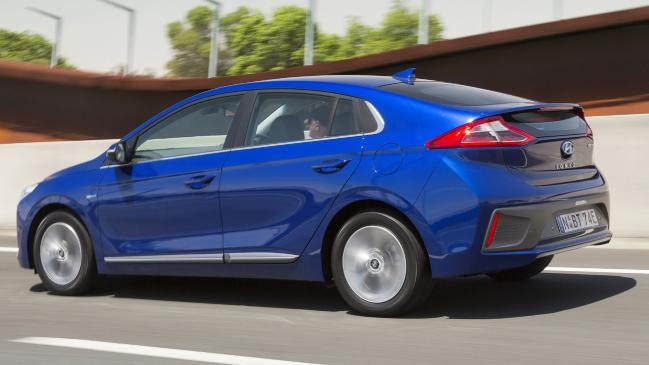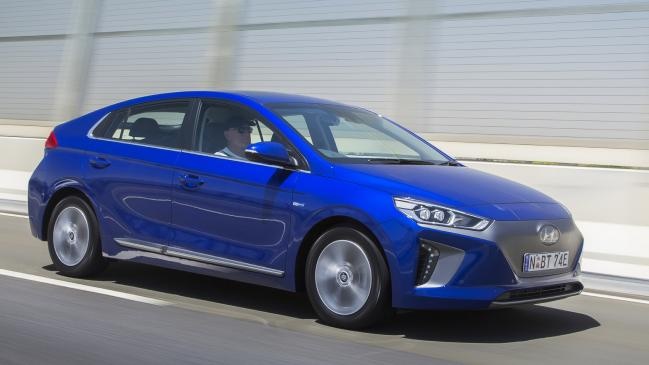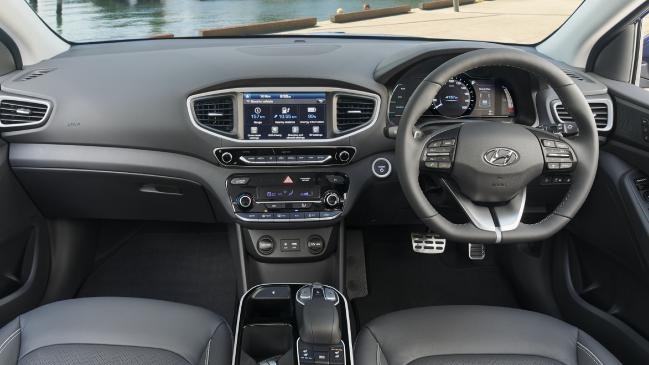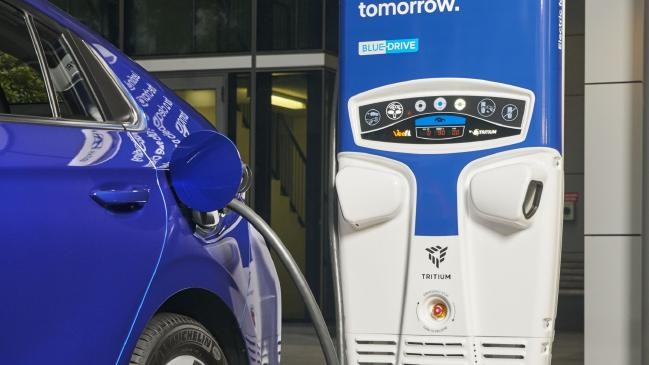



A new motoring hierarchy is forming with the arrival of electric cars and one surprising brand is trumping the former stars of the car world.
BILL McKINNON from CarsGuideHyundai’s electric SUV makes a strong first impression but doesn’t come cheap.
In the brave new world of electric vehicles, the established hierarchy of manufacturers no longer applies.
From exotic performance brands such as Ferrari and Porsche, to your meat and three veg merchants such as Holden and Mitsubishi, they’re all learning how EV technology works. This is a new race — even the bookies don’t know who the favourites are.
Among mass market brands, Hyundai is out in front. It builds the Kona Electric SUV and Ioniq Electric sedan, which we’re driving today.

At about $53,000 drive-away, the Ioniq Electric Elite is Australia’s most affordable EV. Premium grade, with extra luxe including heated/cooled front seats and a sunroof, adds about $4000.
It gets a major engineering update for 2020, including a new 38.3kWh lithium-ion battery, with 36 per cent greater storage capacity, increasing the car’s claimed maximum range from 230km to 311km.
A bigger battery also takes longer to charge. Hyundai claims 54 minutes from zero to 80 per cent capacity at a 100kW public fast charger — or 31 minutes longer than the 28kWh battery in the 2019 model. Fed by a household power point, our test car’s battery took 17 hours 10 minutes to charge from 15 per cent to full. Most owners will spend an extra $1950 to install a wall charger at home. This will achieve zero to 100 per cent — using off peak power at night — in about six hours.

Driving the front wheels via a single speed transmission, the electric motor gets a power boost — now 100kW, up from 88kW.
Hyundai’s Blue Link app allows you to monitor and control the car, including battery status, range and charge scheduling, from your phone.
ComfortThe Ioniq Electric is smoother and quieter than just about any conventional car this side of a Rolls Royce Phantom.
That’s because in a petrol engine hundreds of explosions and assorted acts of mechanical violence occur every second, whereas current flows silently to an electric motor, which has but a single, inherently balanced, moving part. Want peak serenity while you drive? Get an EV.
Hyundai Australia’s suspension tune complements this ultra-refinement, with a supple ride and distinctly non-sporty handling and steering. That said, the Ioniq is fine on the open road, where its low centre of gravity, characteristic of EVs, contributes to its planted, well-balanced feel.
Comfortable, supportive seating extends to decent legroom in the back stalls.
Digital instruments include displays for range to empty and distance to the nearest charging station.

The essentials are there, plus adaptive cruise with stop-go in slow traffic. If the airbags deploy, there is automatic emergency assistance calling.
DrivingIn an EV, power is immediate, effortless and supremely smooth. Since the car was invented in the late 19th century, the world’s best engineers have been trying to make petrol engines go like this.
Around town, you can get nearly 300km from one battery charge. Regenerative braking occurs any time you lift your right foot and the rate is adjustable via paddles on the steering wheel — it’s very effective, to the point that you can use the left paddle instead of the left pedal to brake.
On the highway though, as with other EVs, the Ioniq’s claimed maximum range becomes a lotto number.

I head north from Melbourne on the Calder freeway with an almost fully charged battery and 275km of range showing on the dash.
After 75km at motorway speeds, I’ve got 176km left — so of the range I had when I started, 24km have disappeared.
And the nav tells me the nearest charging station is back in Melbourne.
On the highway, an EV loses about one kilometre of starting range for every three kilometres you travel. Extreme heat or cold can also cut range by up to 25 per cent.
At 100km, I’ve got half left in the battery. The nav is still insisting the nearest charging station is in Melbourne, now 97.6km away.
Retreat or drive on? In a few more kilometres, my fate will be sealed and, no matter which choice I make, we will soon ease silently to a stop. I should have brought an extension lead so I can plug in at Maccas. I wonder if they’ll let me stay overnight?
This is what EV range anxiety looks like, folks.
Lucky I’m close to home. EVs are here and that’s a good thing. But for now, in the wide brown land, petrol is still the fuel of choice to get you there.
Heart saysIt’s time we got out of fossil fuel cars and into EVs. Right now.
Head saysI live in the city and hate road trips. I’ve got big solar grunt on the roof, plus a big battery to store the free, zero emission power it makes for my house. Now, it can run my car too.
Verdict 3.5/5Ioniq is arguably the best of them.
AlternativesSecond generation Leaf, the world’s top-selling EV, has a 40kWh battery that provides up to 270km of claimed range. 110kW of power.
Tesla Model 3 from $67,900 plus on-roadsTesla’s DNA is pure EV, so as far as range and performance are concerned it’s in a different league. Model 3 claims up to 460km of range and 225kW of power.
Hyundai Ioniq electric vitals:
Comment by red-jos editor, 21 January 2020:
AUSTRALIA HAS BEEN STUCK IN THE SLOW LANE ON ELECTRIC VEHICLES SINCE THE 1980s OR EARLIER, BECAUSE FROM 1980 TO 1985 THE WRAN AND FEDERAL GOVERMENTS FUNDED A PROJECT FOR TESTING ALTERNATIVE FUELS IN VEHICLES. AT THE END OF THE 5 YEAR TEST PERIOD WHEN THE PROJECT WAS NO LONGER FUNDED, AND CLOSED DOWN, THE DEPARTMENT AT THE ENERGY AUTHORITY OF NEW SOUTH WALES, WHICH HAD RUN THE PROJECT, PREPARED A REPORT FOR THE NEW SOUTH WALES GOVERNMENT, BUT THE WRAN LABOR GOVERNMENT HAD BEEN REPLACED BY A LIBERAL GOVERNMENT AND THE DEPARTMENT IN THE ENERGY AUTHORITY WHICH HAD PREPARED THE REPORT WAS RUN BY PEOPLE WHO SUPPORTED THE LIBERAL GOVERNMENT AND REFUSED TO SUBMIT THE REPORT TO THE NSW PARLIAMENT SO EVERYTHING CAME TO AN END IN RELATION TO ELECTRIC VEHICLES.
NOW, 40 YEARS LATER AND THE WORLD IS TURNING TO ELECTRIC VEHICLES AND AUSTRALIA HAS SLUMBERED IN SLEEPY HOLLOW AND RESIDES THERE WITH MOST AUSTRALIAN STATE AND FEDERAL GOVERMENTS.
WHAT A TRAGIC SET OF MISSED OPPORTUNITIES.
Almost a year ago, a Senate inquiry into electric vehicles recommended the federal government lead the way in promoting the uptake of such vehicles. The committee urged the government to set targets for how many electric vehicles might be on the road decades from now, to develop a national strategy with the states about charging infrastructure and commit to transitioning to battery-powered vehicles for the government fleet.
A few weeks later, the Morrison government unveiled what it called a "Climate Solutions Package", a pitifully inadequate five-point policy that effectively relaunched its earlier Direct Action effort. One of the key points of that initiative was a national strategy for electric vehicles. If evidence were needed of the Coalition's history of deflection and indecisiveness about climate change, it is right there in that vacuous, single-page strategy on electric cars.
Put shortly, there is no strategy. There is no policy, no target and so far little evidence of a plan.
And in the weeks before the May election, the Coalition buckled under the hysterical tripe emanating from some conservative commentators that falsely claimed government policies to reduce emissions and shift to electric vehicles would lead to tradies losing their trusty utes. That was symptomatic of the quality of much of the discussion about climate change last year.
Meanwhile, the devastating and continuing bushfires this season have demonstrated climate change is taking hold. It is long past time for the Morrison government – and governments worldwide – to get real about genuine, practical climate-change strategies.
A simple one would be to focus on vehicle emissions and promoting electric vehicle use, perhaps through tax or other financial incentives. And as consumers we should embrace electric vehicles. The concept that they don't suit Australia because of the long distances is largely a furphy. How many of us actually drive those long distances between cities on a regular basis?
According to the Department of Environment and Energy's June quarter update for Australia's greenhouse emissions, transport represented 18.9 per cent of the nation's overall emissions in 2018-19 – second only to emissions generated by electricity-generating power stations.
And the 2017 National Inventory Report on emissions, submitted to the United Nations Framework Convention on Climate Change, noted "transport emissions are one of the strongest source[s] of emissions growth in Australia".
Indeed, the department's June quarterly update (the latest available figures) shows the transport sector has experienced the largest increase in emissions of all sectors in the past three decades – up 63.5 per cent from 1990 to June 2019.
Here is a relatively easy policy for the Morrison government that might shift it from the indolent passivity and obstructionist tactics that have hallmarked its approach to climate change, and position it instead as a front-runner stepping into action.
That is what the world's biggest car manufacturers are already doing. That is also what the world's leading economies are doing: China, South Korea, Germany, France, Britain and individual states in the US, as well as Japan, Norway, the Netherlands and more have set targets and are providing incentives for consumers to switch to electric vehicles.
If Prime Minister Scott Morrison really wants to build credibility around climate change strategies, he should act now to promote the uptake of electric cars. Set a target. Change over the fleet. Stop wavering and do it. And we should overcome any bias we may have against electric vehicles – most of the rest of the world has.



DVD: "Who Killed the Electric Car? (2006)
Available in Australia


Mannie and Kendall Present: LESBIAN AND GAY SOLIDARITY ACTIVISMS
Mannie's blogs may be accessed by clicking on to the following links:
MannieBlog (from 1 August 2003 to 31 December 2005)
Activist Kicks Backs - Blognow archive re-housed - 2005-2009
RED JOS BLOGSPOT (from January 2009 onwards)

This page was created on 4 JULY 2021
PAGE